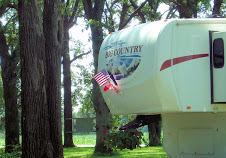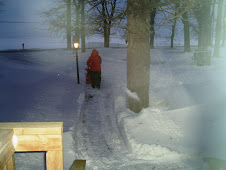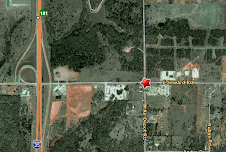Baxter Springs is the site of Fort Blair and the Battle of
Baxter Springs. Located in the southeast corner of Kansas, it was once a rest
stop for the Osage Indians as they traveled to their summer hunting grounds. The Osage believed that the spring water had
miraculous healing properties and they routed their trek purposely to use the
flowing springs.
In the spring of 1849, John Baxter,
his wife and 8 children moved from Missouri to 160 acres of land near the Spring
River. His land included a spring and there he built and operated an inn and general
store, known as "Baxter's Place.”
In the spring of 1862, a field camp, Camp Baxter
Springs, was built by Col Charles Doubleday's 2nd Ohio Brigade and Colonel
William Weer's 2nd Kansas Brigade to garrison about 6,000 troops. Situated on the old military road
from Fort Smith AR, through Fort Scott KS and southwest to Fort Gibson in
Indian Territory (OK), the field camp, and later the fort, served as a rest
stop for the wagon trains that supplied the troops and to house military
personnel assigned to protect them from hostile Indians and thieves along the journey.
Several more field camps were established along the
route: Camp Little Five Mile, built by
Col John Ritchie’s Indian Home Guards in June, 1862; in 1863 Camp Joe Hooker
and Camp Ben Butler were both built by Col James Williams' 1st Kansas Colored
Troops.
In July, 1863, Col Charles Blair sent Lt John Crites
with companies C and D of the 3rd Wisconsin Cavalry to convert Camp Baxter
Springs into a permanent garrison. It
consisted of a block house and a few cabins surrounded by breastworks made of
logs, rocks and dirt. Officially named
Fort Blair, it was often referred to as Fort Baxter.
Crites was reinforced by a detachment of the Second
Kansas Colored Infantry under command of Lt R. E. Cook, and early in October
further reinforcements were added under Lt James B. Pond of the Third Wisconsin
Cavalry, which provided a 12-pound howitzer.
When the Civil War began, the area was soon under attack by Confederate
regular and guerrilla forces.
On October 4, 1863, Lt Pond arrived from Fort Scott
to take command of the post, manned with 155 men. Setting up camp about 200
yards west of the fort, Pond made the decision the fort needed to be
enlarged. The following day he ordered
the west wall removed to start the construction of a larger fort.
 The morning of October 5th, when Lt Pond
sent out a foraging party of 60 men with all the wagons, leaving only 90 men in
camp, he had no way of knowing William Quantrill and 400 guerillas were
traveling south through Kansas along the Texas Road to winter in Texas.
The morning of October 5th, when Lt Pond
sent out a foraging party of 60 men with all the wagons, leaving only 90 men in
camp, he had no way of knowing William Quantrill and 400 guerillas were
traveling south through Kansas along the Texas Road to winter in Texas.
After capturing and killing 2 Union teamsters on the
Texas Road from Fort Blair, Quantrill set his eyes on Fort Blair. When the guerillas started the attack, Lt
Pond manned the howitzer to fight off the guerillas. Quantrill's men suffered a
few casualties but moved on and found another battle.
The
Battle of Baxter Springs (Baxter Springs Massacre - October 6, 1863)
Gen James G Blunt left Fort Scott on October 4th
with an escort of 100 men from the Third Wisconsin and Fourteenth Kansas
Cavalry, headed to Fort Smith, Arkansas.
Unaware of the earlier attack on
Fort Blair, about noon on Oct 6th, Gen Blunt and his command were caught totally by surprise when
they spied a body of mounted men advancing from the trees along the Spring
River. Dressed in Federal uniforms, Blunt thought they were Pond's men and sent
his Chief of Scouts, Captain Tough, to meet them. Tough returned; the men were not Union
soldiers, they were rebels.
The men, Quantrill's guerrillas, began an attack on
Blunt’s troops. Highly outnumbered the
Union troops scattered. One officer reached Fort Blair to tell Pond about the
turn of events, but no aid was available.
After the
attack, Quantrill called for the surrender of Blair's troops and shot dead
those that surrendered. General Blunt, with 15 of his men escaped
and eventually made their way back to Fort Scott.
Immediately after destroying Blunt's force, the
guerrillas plundered the supply wagons, finding weapons, food, and whiskey. Two
of Quantrill's leaders, George Todd and William "Bloody Bill"
Anderson, wanted to attack Fort Blair again, Quantrill was more concerned about
carrying away his wounded men. The
guerrillas continued their southward march.
In the end, it was a Confederate victory, with 85 of
Blunt's men killed or dying from their wounds and another 8 wounded. Six of
Pond's men were killed and 10 were wounded. It is estimated 20-30 guerillas
were killed and at least 3 wounded.
All of the
casualties were buried near the fort. Following the massacre, Blunt was
temporarily dismissed from his command, but was later reinstated. In 1885,
Congress appropriated $5,000 for a national cemetery a mile west of Baxter
Springs, where many of the bodies were re-interred.
When the Civil War was over, the
fort was abandoned but the town grew, becoming one of the wildest cow-towns in
the West. Corrals were constructed for
approximately 20,000 head of cattle with ample grazing lands and fresh water. The
demand for beef brought Texas cattlemen north using Baxter Springs as a
stopping point enroute to the northern markets. The cattle drovers found Baxter
Springs a welcome break after months on the trail. The numerous saloons provided
all the things and activities a cowboy could use. All prospered until the railroad came
through and went on to Texas.
At the Battle of Baxter Springs, he fought against the notorious Confederate guerrilla leader William Quantrill and his Raiders. For his heroism in that action, he was awarded the Medal of Honor on March 30, 1898. By the time he mustered out in September 1865, he had been promoted to the rank of major.
Medal of Honor citation
For extraordinary
heroism on 6 October 1863, while serving with Company C, 3d Wisconsin Cavalry,
in action at Baxter Springs, Kansas. While in command of two companies of
Cavalry, First Lieutenant Pond was surprised and attacked by several times his
own number of guerrillas, but gallantly rallied his men, and after a severe
struggle drove the enemy outside the fortifications. First Lieutenant Pond then
went outside the works and, alone and unaided, fired a howitzer three times,
throwing the enemy into confusion and causing him to retire.

























